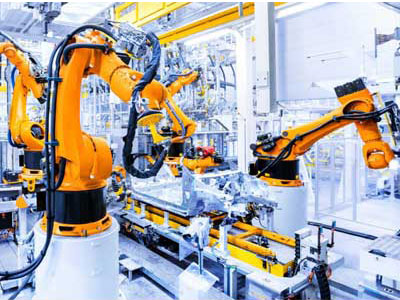Key Takeaway
In the automobile industry, robots play a crucial role in automating repetitive and precise tasks. They are widely used in car assembly lines to install parts accurately, apply adhesives, and perform intricate assembly processes. Robots enhance efficiency and consistency, ensuring high-quality production. Additionally, they improve safety by handling dangerous tasks, reducing the risk to human workers. From welding to painting and assembling, robots significantly contribute to the modern automotive manufacturing process, making it faster and more reliable.
Assembly Line Automation
In the automobile industry, robots play a crucial role in assembly line automation. They handle tasks such as installing car doors, windshields, and wheels with precision and consistency. Robots ensure that each part is fitted accurately, reducing human error and increasing production speed. This automation allows manufacturers to produce cars faster and with greater uniformity, improving overall quality and efficiency. For example, automotive giants like Toyota and Ford utilize robots extensively on their assembly lines, enabling them to meet high production demands while maintaining strict quality standards.

Welding and Painting
In the automobile industry, robots have revolutionized welding and painting processes. Welding robots, equipped with precise control systems, ensure strong, consistent joints on car frames. They operate continuously without fatigue, drastically increasing production efficiency and minimizing the risk of errors. These robots handle various welding tasks, from spot welding to arc welding, with exceptional precision. Their ability to work tirelessly without breaks makes them indispensable in modern manufacturing, where maintaining high productivity and quality is paramount.
Painting robots, on the other hand, apply paint coats evenly and efficiently, delivering a high-quality finish every time. Operating in controlled environments, these robots reduce exposure to harmful fumes, ensuring a safer workspace. Companies like Tesla and General Motors use these robots to achieve perfect, consistent paint jobs, which are crucial for both aesthetic appeal and corrosion protection. The robots’ precision and reliability in these tasks exemplify how automation can enhance product quality while safeguarding worker health.
Quality Control
Quality control is critical in ensuring that every vehicle leaving the factory meets stringent standards. Inspection robots, equipped with advanced sensors and cameras, detect defects and measure dimensions with high accuracy. These robots can identify surface scratches, misalignments, and other imperfections that might be missed by human inspectors. Their ability to perform detailed inspections quickly and accurately ensures that manufacturers maintain high-quality standards without slowing down production lines.
Automating quality control reduces the risk of recalls and warranty claims, saving manufacturers substantial costs and protecting their brand reputation. The robots’ precision ensures that each vehicle is thoroughly inspected, enhancing product reliability. By integrating robots into the quality control process, companies can consistently deliver vehicles that meet customer expectations and industry standards. This automation not only boosts efficiency but also instills greater confidence in the product’s quality and durability.
Parts Handling and Sorting
Robots play a crucial role in parts handling and sorting within automobile factories. They manage the movement of components, ensuring timely delivery to various production stages. This automation streamlines the supply chain, reducing bottlenecks and increasing overall efficiency. Robots can quickly sort parts based on size, type, and production stage, minimizing the risk of mix-ups and delays. Their ability to handle large volumes of parts with precision is invaluable in maintaining a smooth production flow.
In large factories, manually managing thousands of parts would be impractical and error-prone. Robots take over this task, enhancing accuracy and speed in parts handling. By automating these processes, manufacturers can focus on more complex tasks, knowing that the parts handling and sorting are efficiently managed. This not only boosts productivity but also ensures that the right components are always at the right place at the right time, critical for maintaining continuous production.
Customization and Flexibility
Robots significantly enhance customization and flexibility in automobile manufacturing. Programmable to handle various tasks, they adapt quickly to new production requirements. This flexibility allows manufacturers to offer customized options to customers, such as different paint colors, interior finishes, and additional features. Robots enable factories to switch between different models efficiently, responding to market demands without extensive retooling, making them essential for modern manufacturing agility.
Companies like BMW and Audi leverage robotic automation to provide a wide range of customizable options while maintaining high production efficiency. The ability to quickly adjust production processes ensures that customer preferences are met without compromising on quality or speed. This adaptability is crucial in today’s competitive market, where manufacturers must meet diverse customer demands while maintaining efficiency and consistency. Robotic automation thus stands at the forefront of innovation, driving the future of customized, flexible manufacturing in the automobile industry.
Conclusion
Robots have revolutionized the automobile industry by enhancing efficiency, precision, and flexibility. From assembly line automation and welding to quality control and parts handling, robots play a vital role in every stage of car manufacturing. Their ability to perform repetitive tasks with high accuracy and reliability ensures that vehicles are produced quickly and consistently to high standards. As technology advances, the integration of robots in the automobile industry is expected to grow, further optimizing production processes and enabling manufacturers to meet evolving market demands with agility and innovation.
